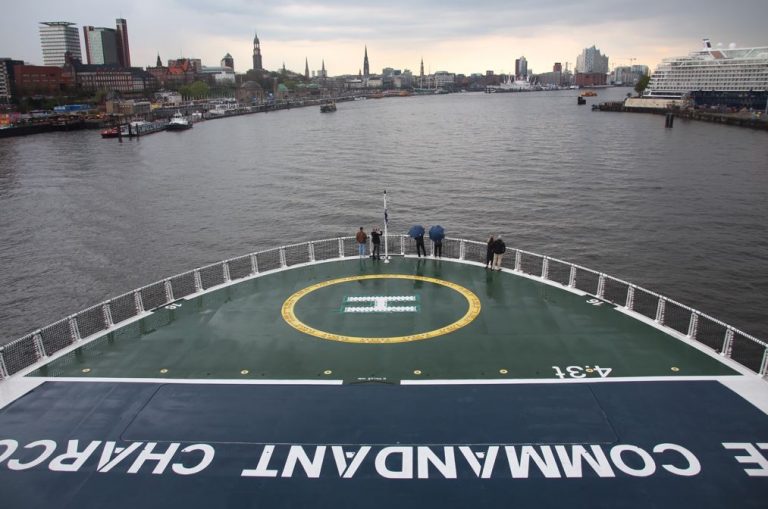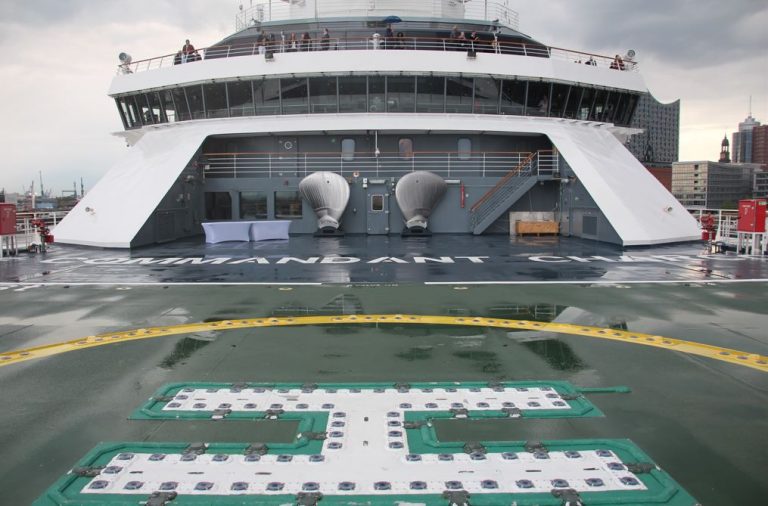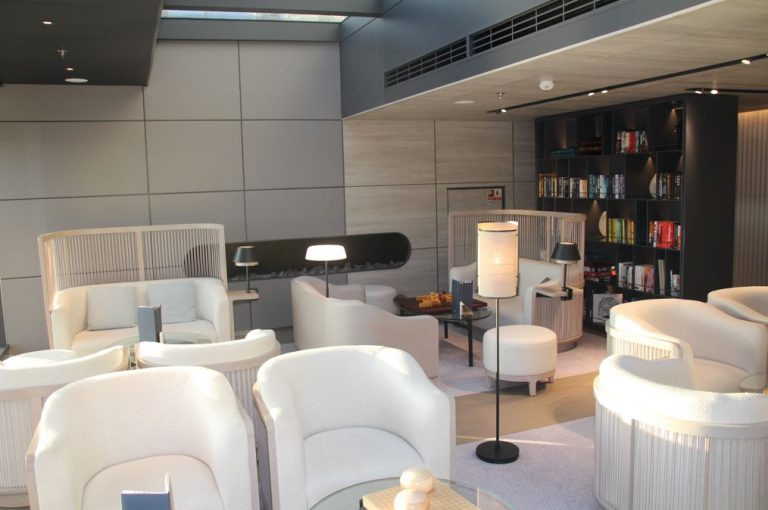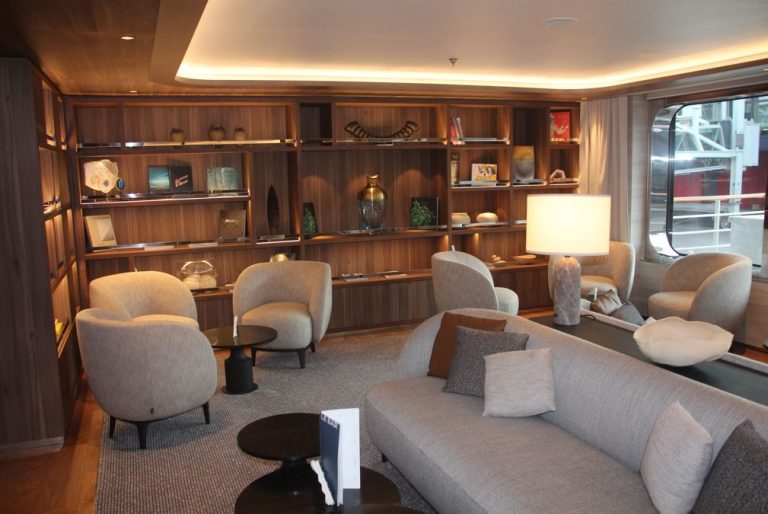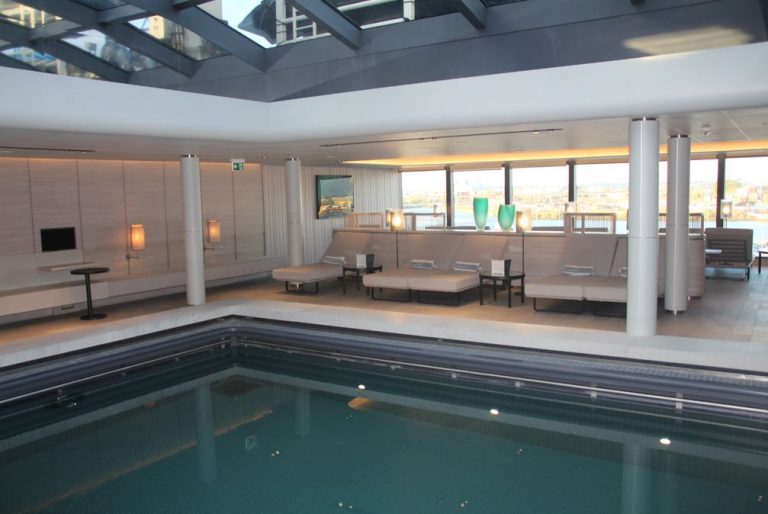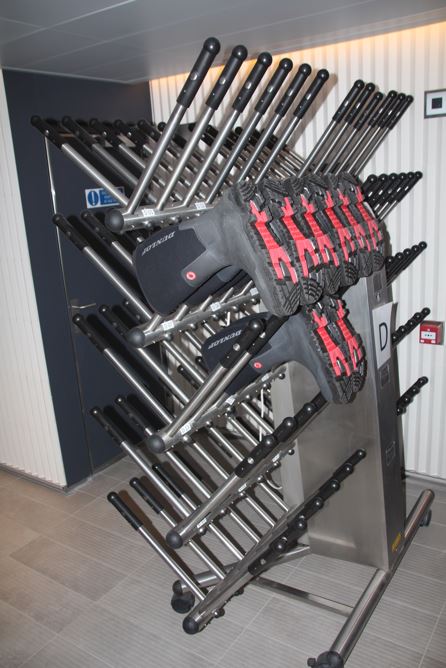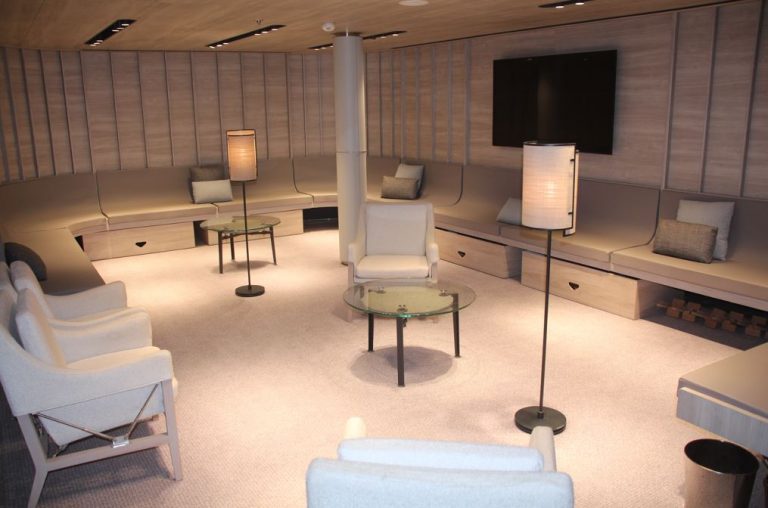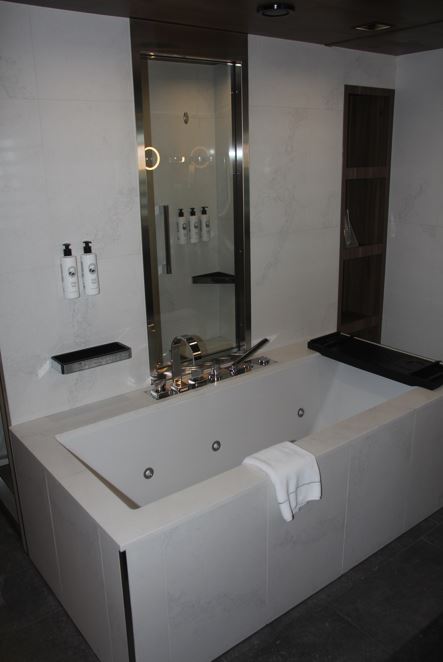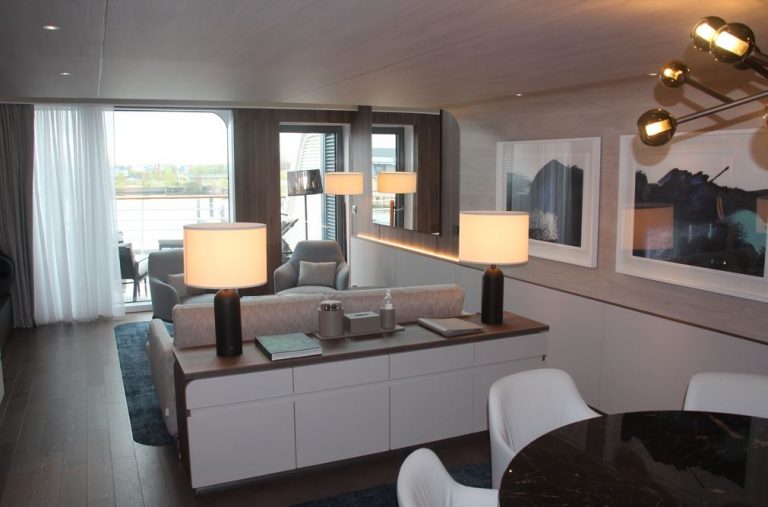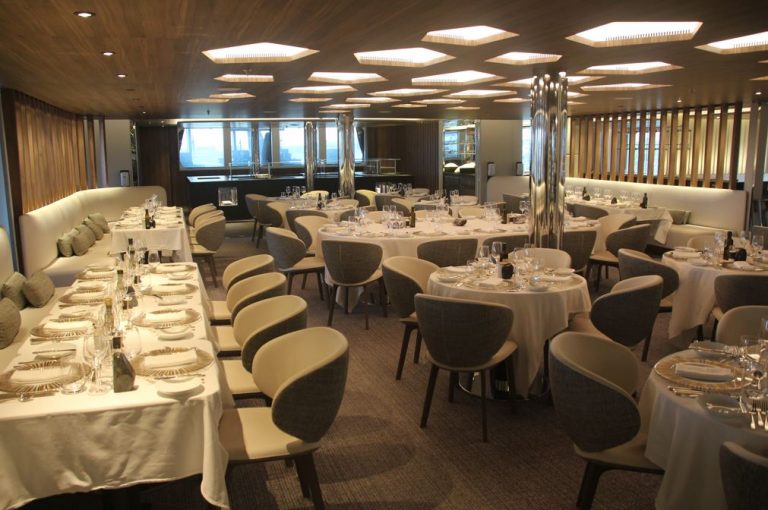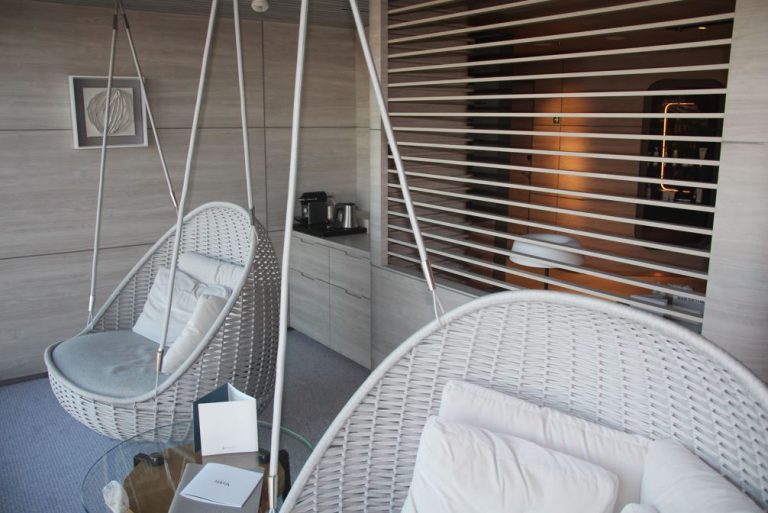Le Commandant Charcot: a luxury ice-breaker
This ship is unique. It can effortlessly break polar ice, is powered by LNG and has its own fully-equipped science lab onboard. Her guests meanwhile enjoy the highest level of luxury and sail on what can be regarded as the most spectacular cruise itineraries in the world.
Named after Jean-Baptiste Charcot (1867 – 1936) who was a doctor, sailor, adventurer and scientist in one, the flagship of Ponant Cruises pays tribute to a true polymath. Two Antarctic expeditions (1903 to 1905 and 1908 to 1910) had taken Charcot to “Terra Australis”, countless others to Greenland, Svalbard and the Arctic Ocean. Various bays and glaciers today bear his name, as well as a French Antarctic research station and a French research ship (both now decommissioned). Accepted into the French academy of sciences during his lifetime, Charcot after his death received a state funeral in Notre Dame. He was a true national hero.
Le Commandant Charcot
It is most fitting therefore that his name has been chosen for a cruise ship that is as unique as France’s most famous polar explorer himself. As far back as in 2015, Compagnie du Ponant (Ponant Cruises) had begun to design a ship that would be both an icebreaker and a luxury cruise ship, taking its guests farther north and south than any other vessel before her. But not only that, the luxury icebreaker was also to set new standards in terms of environmental friendliness and sustainability, running on LNG and batteries instead of marine diesel oil. But neither a passenger ship suitable for pack ice navigation nor a cruise vessel with electric hybrid propulsion had been built before at that time, so Ponant really broke new ground in every respect with the construction of the Le Commandant Charcot.
Fit for the North Pole
It took six years before Le Commandant Charcot was able to embark on sea trials in the summer of 2021 – a voyage during which she became the first French ship ever to break through the Arctic ice in order to reach the geographic North Pole. This is possible thanks to the vessel being fitted with an ice-strengthened hull so strong that the Le Commandant Charcot is classified with “Polar Class 2”, fit for “year-round operation in polar waters with moderate multi-year ice.” Only Russian nuclear icebreakers are more robust still, but their tourist cruises were suspended in 2022. (Most “soft” expedition cruise ships are certified with ice class PC6, allowing them to operate “in summer and fall in moderate one-year ice”. The cruise ships SH Minerva, SH Vega, National Geographic Resolution and National Geographic Endurance, which are classified with ice class PC5, hold an intermediate position).
Le Commandant Charcot
Le Commandant Charcot
In addition, the ‘Charcot’ is designed as a “Double Acting Vessel.” Her two self-propelled ice-resistant Azipods can rotate by 360°, giving the ship exceptional manoeuvring capabilities. At the stern, the ship’s officers even have a second wheelhouse at their disposal for safely navigating through the ice.
It is also no secret that the unique design of the Le Commandant Charcot came at considerable cost for her owners. Her building price is reported to be some € 274 million; the Spirit of Adventure which was delivered in the same year and which is twice as large was only slightly more expensive. On the other hand, the Ponant ship outperforms the Spirit of Adventure in terms of power – 42,000 kW on board the Le Commandant Charcot compared to only 21,000 kW on board Saga Cruises’ “fine weather ship”. In one respect, Le Commandant Charcot even competes with Cunard Line’s giant Queen Mary 2 – her draught of ten meters which is due to her heavy ice-strengthened hull is so considerable that on the occasion of her showcase trip to Hamburg, the relatively small polar expedition ship had to use the city’s deep-water cruise terminal in Steinwerder rather than one of the more prominent berths on the banks of the Elbe River. For safety reasons, ships with a draught of ten meters or more are not allowed to pass over the old Elbe tunnel.
Le Commandant Charcot
Low emissions
It was therefore with great pride that the entire management team of Ponant Cruises together with the German office presented the company’s flagship to the press on a Sunday in April. Ponant’s President Hervé Gastinel welcomed the guests in the onboard theatre and introduced the ship and shipping company to the audience – together with Patrick Marchesseau (Captain), Mathieu Petiteau (Newbuilding Director) and Steven Moir (Expedition Leader).
Two aspects of the Le Commandant Charcot were of paramount importance to the Ponant representatives: the ship’s environmental friendliness and her hybrid role as a passenger and research ship which makes her indeed unique in the world. After all, the aim of her cruises according to Ponant is nothing less than “the combination of travel and meaningfulness, knowledge and cosmopolitanism, adventure and new discoveries”.
Le Commandant Charcot Panorama Lounge (2)
Le Commandant Charcot Panorama Lounge (2)
Le Commandant Charcot Main Lounge
Thanks to her capability to store large quantities of LNG onboard, Le Commandant Charcot can travel to the polar regions for up to two months without refuelling. Ponant therefore calls her a “revolutionary polar expedition ship with hybrid propulsion”. Two huge tanks with a combined capacity of 4,500 m3 make it possible to carry out expedition cruises that are considerably longer than those of her competitors. (Technically, the ship has a dual fuel engine so that in an emergency it can also run on marine diesel oil instead).
And when whale or other wildlife watching is on the agenda, Le Commandant Charcot can easily switch to battery mode. For up to one hour, the vessel will then pass through water and ice not only without emissions, but also without making any noise. You don’t even have to feel guilty when you make use of the heated benches on the sun deck or the two swimming pools on board – their heat comes directly from the ship’s own energy recovery system. Moreover, all waste and wastewater is being sorted and treated on board, while disposable plastic is dispensed with completely at Ponant. Instead of plastic bottles or tetra packs, Ponant provides high-quality reusable bottles which can be refilled at dedicated stations in the public rooms.
Le Commandant Charcot Indoor Pool
Le Commandant Charcot Bar Inneq
A (research) ship within a (cruise) ship
The sustainability of Le Commandant Charcot is not least a concern for the scientists on board, who – also uniquely – live and work on the ship for longer periods. Prof. Christian Haas and Dr. Marcel Nicolaus from the Alfred Wegener Institute (AWI) in Bremerhaven during the onboard press conference in Hamburg explained details of the concept: Two laboratories deep inside the Le Commandant Charcot allow scientific research to be carried out while the cruise is in operation, which turns out to be fortunate in several respects. Firstly, there are currently only four Western research vessels able to sail into polar pack ice (the American Polar Sea, the Canadian John G. Diefenbaker, the Norwegian Kronprins Haakon and the German Polarstern), and these ships are not always where the scientists would like them to be for their own respective research.
Le Commandant Charcot Pool
The Le Commandant Charcot, on the other hand, returns to both the high Arctic and the deep Antarctic for several months in a row every year. This not only makes it possible for the scientists to plan their research work over the longer term, but also allows them to carry out entire series of data collecting when they would otherwise only be able to take random samples. Accordingly, not only the German AWI researchers are enthusiastic about the unique opportunity to exchange their laboratory on the Polarstern for that on the French cruise ship. The French ship is also more modern (the Polarstern was built in 1982), and allows direct interaction with the public, which is ultimately the purpose of every research. The fact that the public in form of the Le Commandant Charcot’s enthusiastic passengers can even actively participate in some of the experiments is the icing on the cake. 19 to 23 experts and scientists accompany the Le Commandant Charcot on each of her voyages, truly living up to the vessel’s dual role as cruise and polar research ship.
Le Commandant Charcot Buffet
To the last frontiers
Nevertheless, the main focus onboard is on the expedition experience to be had by the paying guests who chose the Le Commandant Charcot to go to destinations that they probably only visit once in a lifetime. The names Blosseville Coast, Marguerite Bay and Marie Byrd Land don’t ring a bell? Well, you may be forgiven for that – no other ship apart from the Le Commandant Charcot can visit these remote spots. (Blosseville Coast is a stretch of icy shore on Greenland’s east coast, Marguerite Bay is a bay on the west side of the Antarctic Peninsula, and Marie Byrd Land in Antarctica is the largest unclaimed territory on earth.)
In Antarctica, the Ponant icebreaker’s destinations also include the Bellinghausen Sea, the Weddell Sea with the Larsen ice shelf, and the Ross Sea – destinations impossible to reach by ships that are not equipped with an ice-strengthened hull. The rewards of travelling to these last frontiers include visiting colonies of the majestic emperor penguins, sightings of the rare Ross Seal or getting a glimpse of the fluke of a blue whale, the biggest creature to ever live on earth.
Le Commandant Charcot Expedition
Le Commandant Charcot Expedition
On the opposite side of the planet, Le Commandant Charcot sails to both the geographic and magnetic North Pole, cruises along the Greenland coasts, anchors off the shores of Svalbard and, weather permitting, even crosses the famous Northwest Passage – sled dog rides, Zodiac excursions and snow boot hikes included. As for the polar experience, Ponant promises “not the same strains that the explorers had endured, but the same intensive emotions”.
During the Le Commandant Charcot’s Arctic cruises, Ponant even offers to stay overnight in a tent on the ice outside the ship – a local polar bear guard provided, of course. In the Arctic, help and assistance from the local Inuit community is essential anyhow, expedition leader Steven Moir stresses. Their knowledge and experience with regard to weather and wildlife is invaluable. And there is only so much the cruise operator can give to the Inuit in return, but one form of gratitude apart from donating fresh fruit and vegetable is swimming lessons in the ship’s two pools. For this is one of the few things that the indigenous people of Greenland and northern Canada for obvious reasons never do.
Le Commandant Charcot Expedition Room
Apart from that, Ponant also pays respect to the Inuit by giving all public spaces onboard the Le Commandant Charcot names derived from the vocabulary of the Arctic peoples’ local languages. From the observation lounge “Anori” (wind) to the restaurants “Nuna” (earth) and “Sila” (air) and from the sauna “Ikuma” (fire) to the snow room “Siku” (ice) and the indoor pool “Imaq” (ocean), Inuit visitors could feel at home immediately, at least linguistically.
Five-star luxury
As for the interior of the ship itself, on the other hand, the contrast between the deprived life of the Inuit in the Arctic and the luxury offered by the Le Commandant Charcot and her crew could not be greater. The ship´s designers Jean-Philippe Nuel and Jean-Michel Wilmotte have tried to create an onboard interior that harmonizes with the landscape outside, and they have magnificently succeeded in doing so throughout the ship. Of the seven cabin categories for the maximum 245 passengers onboard, six categories alone are suites ranging in size from 28 m2 to 115 m2.
Le Commandant Charcot Deluxe Suite
Le Commandant Charcot Deluxe Suite
Le Commandant Charcot Duplex Suite
The wellness area of the Le Commandant Charcot is an impressive 430 m2 in size, massage cabins and hairdresser have sea views, and even the helicopter deck at the bow of the ship is accessible to passengers in good weather. Every design aspect onboard has the polar experience of the passengers in mind.
During the press event in Hamburg, the invited guests were treated with the same fine cuisine the company’s paying passengers enjoy on the ship’s regular polar cruises – gourmet menus created by the French chef Alain Ducasse with whom Ponant has established a collaboration in 2016.The menu on that gala evening read as follows: First course: Caramelized corn velouté, foie gras and Comté crumble; second course: King prawn tartar, avocado, citrus, Oscietra caviar from Kaviari; main course: Seabream fillet, lettuce cream and Oscietra caviar from Kaviari or Beef tenderloin, roasted foie gras, carrot variation, roasted hazelnuts, buckwheat tuile; and dessert: Chocolate Le Commandant Charcot – a 1:1000 miniature of the ship made from chocolate creme. One course came along more delicious and artfully presented than the other and, together with fresh rolls from the onboard bakery and Ponant’s first-class house wine, made for a perfect ensemble.
Le Commandant Charcot Nuna Gourmet Restaurant
Le Commandant Charcot Spa
The fact that the ship herself had left the cruise terminal shortly beforehand to sail from Steinwerder along the Elbe River to Hamburg’s world-famous Elbphilharmonie concert house and back, was another highlight – a harbour boat trip “deluxe”, if you will and in which everybody onboard happily participated – regardless of the inclement weather.
The owner of Ponant Cruises
Since 2015 is no other than François Pinault, the French entrepreneur (Gucci, Yves Saint Laurent, Christie’s), art collector and multi-billionaire. Eight ships (seven of them newbuildings) have joined the Ponant fleet since he took over the shipping company, and there are already plans for another: Ponant’s “Zero Impact ship” which is currently being designed is to operate entirely without fossil fuels and therefore completely emission-free. As in 2015 with Le Commandant Charcot, the technology to build such a ship is still in its infancy, but Ponant is not deterred by this. The next revolutionary cruise ship for Ponant is set to be launched in Marseille or Le Havre in 2027. Chapeau!
Don’t miss more updates, news and reviews of Ponant on Cruising Journal with photos, videos and cruise offers.

